Swedish film actress Mona Mårtenson (1902–1956) appeared in 28 films between 1923 and 1949. With her friend Greta Garbo, she had her big breakthrough in the silent masterpiece Gösta Berlings saga (1924). Garbo went to Hollywood and became a legend, but Mårtenson also had an impressive stage and film career in Scandinavia.

German postcard by Trianon-Film, 1924. Photo: Svenska-Film. Publicity still for Gösta Berlings saga / The Atonement of Gösta Berling (Mauritz Stiller, 1924).
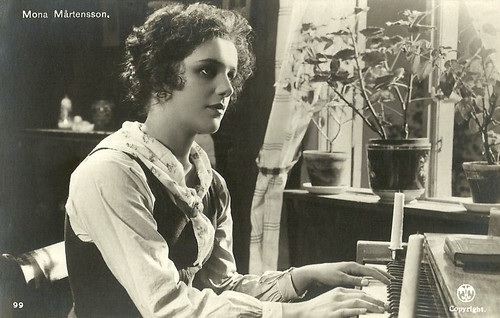
Danish postcard by Alex. Vincent's Kunstforlag, Copenhagen, no. 99. Mona Mårtenson in Ingmarsarvet / The Ingmar Inheritance (Gustav Molander, 1925).
Monica Ingeborg Elisabeth ‘Mona’ Mårtenson was born in Stockholm, Sweden, in 1902. She grew up in Helsingborg and studied at the Dramatens elevskola (Royal Dramatic Theatre Academy). She made her first film appearance in Anderssonskans Kalle på nya upptåg / Kalle Andersson's New Pranks (Sigurd Wallén, 1923). That same year, Mona and her classmate Greta Gustafson (who would change her name to Greta Garbo that same year) were selected by the school to audition for noted Swedish film director Mauritz Stiller.
Both girls got parts in Stiller's upcoming film, the epic romance Gösta Berlings saga / The Atonement of Gösta Berling (Mauritz Stiller, 1924). The film was based on the book by Selma Lagerlöf and features Lars Hanson as the young and attractive minister Gösta Berling. Because Berling has a drinking problem and his sermons are far too daring, he is finally defrocked. Shamed, he is later hired by an unscrupulous and wealthy woman to be a tutor to her beautiful step-daughter (Mona Mårtenson).
At Film Reference, Ronald Bowers writes: "Gösta Berlings saga is regarded by many as Sweden's Gone With the Wind. With an epic sweep, episodic structure, and numerous characters, it evokes 19th-century Swedish life and is imbued with a lyricism and vibrancy which places its director, Mauritz Stiller, among the masters of silent film. The film represents both the pinnacle and the swan song of the ‘golden age’ of Swedish cinema: 1913-1924. With its plot centring on the search for redemption by Gösta Berling, the defrocked priest, and the several women who disastrously fall in love with him, it numbers, along with D.W. Griffith's Intolerance, among the earliest important films of social protest and one of the masterpieces of silent cinema."
After the huge success of the film, Mårtenson did not leave Sweden for Hollywood like her director and co-stars, although, as the site Moviediva suggests, Louis B. Mayer also offered her a contract. Mårtenson stayed in Stockholm and went to work for Dramaten, the Royal Dramatic Theatre in Stockholm. She also appeared in such films as Skeppargatan 40 / Skeppar Gate 40 (Gustaf Edgren, 1925) with Einar Hanson, the two-part Karl XII (John W. Brunius, 1925) featuring Gösta Ekman, and Ingmarsarvet / The Ingmar Inheritance (Gustav Molander, 1925) with Conrad Veidt.
Gustav Molander directed Lars Hanson and her in another Selma Lagerlöf adaptation Till österland / To the Orient (Gustav Molander, 1926), filmed in Jaffa, Israel. She starred again for Molander in Förseglade läppar / Sealed Lips (Gustaf Molander, 1927), co-starring Fred Louis Lerch and Sandra Milowanoff, and based on a story by Guy de Maupassant. The film was a huge success in Sweden. Initially, the French actress Geneviève Cargese would play the main role, but she fell ill in Stockholm and was replaced by Mona Mårtenson.

Swedish postcard by Axel Eliassons Konstförlag, Stockholm, no. 379, 1924. Photo: Svenska-Film. Mona Mårtenson as Ebba Dohna in Gösta Berlings saga / The Atonement of Gosta Berling (Mauritz Stiller, 1924).
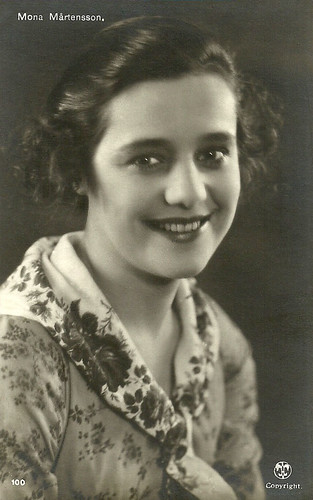
Danish postcard by Alex. Vincent's Kunstforlag, Copenhagen, no. 100. Mona Mårtenson in Ingmarsarvet / The Ingmar Inheritance (Gustav Molander, 1925).
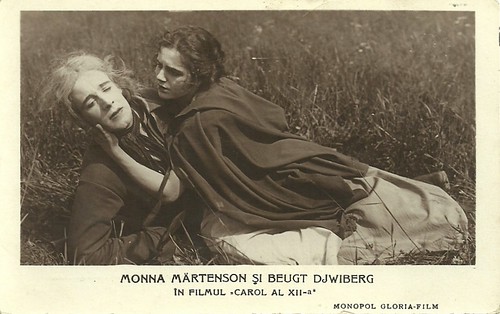
Romanian postcard. Photo: Monopol Gloria Film. Mona Mårtenson (Anna Ulfclou) and Bengt Djurberg (Sven Björnberg) in the Swedish silent film Karl XII (John W. Brunius, 1925), starring Gösta Ekman in the title role.
In Germany, Mona Mårtenson starred in Die Frau im Talar / The Woman in the Robe (Adolf Trotz, 1929) with Aud Egede Nissen and Paul Richter.
In Norway, she appeared in the romantic melodrama Laila (1929), directed by Danish-German filmmaker and noted cinematographer George Schnéevoigt. Martenson featured as Laila, a young girl separated from her parents as a baby and raised by a wealthy reindeer owner, Aslag (Peter Malberg), in the frozen tundra of Scandinavia. Though she returns a year later, Laila grows into a young woman of two worlds, at home with both her settled and nomadic upbringings. Laila soon finds herself in a love triangle with her foster brother Mellet (Henry Gleditsch) and her cousin Anders (Harald Schwenzen), played out against the backdrop of an encroaching plague.
For years, Laila was rarely seen, but in 2006, it was digitally restored by the Norwegian Film Institute and in 2011, it was released on DVD by Flicker Alley. At IMDb, reviewer Hyzenthlay_and_me writes about Laila: “She is played by Mona Mårtenson, who is a wonder to behold. The movie is a drama of faces; there are many hugely expressive faces in the film, and all you can do is sit there and take in their radiance and pure joie de vivre. Mona for example really is a damned livewire, it's all she can do to stop bursting out of her skin, happiness is written all over her face. With silent film, it really does help if you have expressive actors, and they hit the jackpot of them with this movie.”
Schnéevoigt also directed her in Eskimo (George Schnéevoigt, 1930) with Paul Richter. In 1930 she left the theatre company of Dramaten and moved to Gösta Ekman and his Lorensbergsteatern in Göteborg. She would later return to Dramaten. Mårtenson continued her film career smoothly into the sound era. In the Danish comedy I kantonnement / In the cantonment (Lau Lauritzen, 1932) she starred opposite the comic duo Fy og Bi (Carl Schenstrøm and Harald Madsen; also known as Pat & Patachon or Long & Short).
Other sound films in which she starred are I nöd och lust/In Sickness and Health (Ivar Johansson, 1938) and the drama Västkustens hjältar/West Coast heroes (Lau Lauritzen, Alice O'Fredericks, 1940), now as the mother of the hero, played by Fritiof Billquist. In the following years, she played only small roles in Scandinavian films. Her last film was Pippi Långstrump/Pippi Longstocking (Per Gunvall, 1949), the first film adaptation of Astrid Lindgren’s classic children’s novel, only four years after the book was published in Sweden. Pippi was played by the 26-year-old Viveca Serlachius (the eldest Pippi-actress ever), and Mårtenson played a supporting role as Pia. Mona Mårtenson died in 1956 in Stockholm, aged 54.
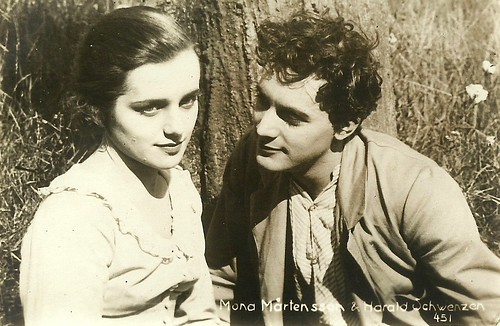
Danish postcard by Helsingin, Helsingfors, no. 451. Photo: Mona Märtenson and Harald Schwenzen in what could be the film Till österland (Gustav Molander, 1926).
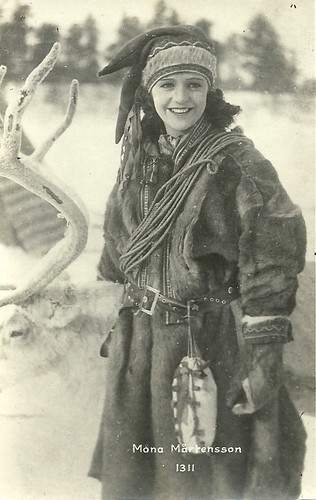
Finnish postcard by Kerttikeskus Kortcentralen, Helsinki, no. 1311. Photo: publicity still for the Swedish silent film Laila (George Schnéevoigt, 1929), starring Mona Mårtenson.
Sources: Ronald Bowers (Film Reference), Hal Erickson (AllMovie - Page now defunct), Phillip Oliver (Greta Garbo – The Ultimate Star), Moviediva, Wikipedia (English and Swedish) and IMDb.
This post was last updated on 31 May 2025.

German postcard by Trianon-Film, 1924. Photo: Svenska-Film. Publicity still for Gösta Berlings saga / The Atonement of Gösta Berling (Mauritz Stiller, 1924).

Danish postcard by Alex. Vincent's Kunstforlag, Copenhagen, no. 99. Mona Mårtenson in Ingmarsarvet / The Ingmar Inheritance (Gustav Molander, 1925).
Lyricism and vibrancy
Monica Ingeborg Elisabeth ‘Mona’ Mårtenson was born in Stockholm, Sweden, in 1902. She grew up in Helsingborg and studied at the Dramatens elevskola (Royal Dramatic Theatre Academy). She made her first film appearance in Anderssonskans Kalle på nya upptåg / Kalle Andersson's New Pranks (Sigurd Wallén, 1923). That same year, Mona and her classmate Greta Gustafson (who would change her name to Greta Garbo that same year) were selected by the school to audition for noted Swedish film director Mauritz Stiller.
Both girls got parts in Stiller's upcoming film, the epic romance Gösta Berlings saga / The Atonement of Gösta Berling (Mauritz Stiller, 1924). The film was based on the book by Selma Lagerlöf and features Lars Hanson as the young and attractive minister Gösta Berling. Because Berling has a drinking problem and his sermons are far too daring, he is finally defrocked. Shamed, he is later hired by an unscrupulous and wealthy woman to be a tutor to her beautiful step-daughter (Mona Mårtenson).
At Film Reference, Ronald Bowers writes: "Gösta Berlings saga is regarded by many as Sweden's Gone With the Wind. With an epic sweep, episodic structure, and numerous characters, it evokes 19th-century Swedish life and is imbued with a lyricism and vibrancy which places its director, Mauritz Stiller, among the masters of silent film. The film represents both the pinnacle and the swan song of the ‘golden age’ of Swedish cinema: 1913-1924. With its plot centring on the search for redemption by Gösta Berling, the defrocked priest, and the several women who disastrously fall in love with him, it numbers, along with D.W. Griffith's Intolerance, among the earliest important films of social protest and one of the masterpieces of silent cinema."
After the huge success of the film, Mårtenson did not leave Sweden for Hollywood like her director and co-stars, although, as the site Moviediva suggests, Louis B. Mayer also offered her a contract. Mårtenson stayed in Stockholm and went to work for Dramaten, the Royal Dramatic Theatre in Stockholm. She also appeared in such films as Skeppargatan 40 / Skeppar Gate 40 (Gustaf Edgren, 1925) with Einar Hanson, the two-part Karl XII (John W. Brunius, 1925) featuring Gösta Ekman, and Ingmarsarvet / The Ingmar Inheritance (Gustav Molander, 1925) with Conrad Veidt.
Gustav Molander directed Lars Hanson and her in another Selma Lagerlöf adaptation Till österland / To the Orient (Gustav Molander, 1926), filmed in Jaffa, Israel. She starred again for Molander in Förseglade läppar / Sealed Lips (Gustaf Molander, 1927), co-starring Fred Louis Lerch and Sandra Milowanoff, and based on a story by Guy de Maupassant. The film was a huge success in Sweden. Initially, the French actress Geneviève Cargese would play the main role, but she fell ill in Stockholm and was replaced by Mona Mårtenson.

Swedish postcard by Axel Eliassons Konstförlag, Stockholm, no. 379, 1924. Photo: Svenska-Film. Mona Mårtenson as Ebba Dohna in Gösta Berlings saga / The Atonement of Gosta Berling (Mauritz Stiller, 1924).

Danish postcard by Alex. Vincent's Kunstforlag, Copenhagen, no. 100. Mona Mårtenson in Ingmarsarvet / The Ingmar Inheritance (Gustav Molander, 1925).

Romanian postcard. Photo: Monopol Gloria Film. Mona Mårtenson (Anna Ulfclou) and Bengt Djurberg (Sven Björnberg) in the Swedish silent film Karl XII (John W. Brunius, 1925), starring Gösta Ekman in the title role.
A wonder to behold
In Germany, Mona Mårtenson starred in Die Frau im Talar / The Woman in the Robe (Adolf Trotz, 1929) with Aud Egede Nissen and Paul Richter.
In Norway, she appeared in the romantic melodrama Laila (1929), directed by Danish-German filmmaker and noted cinematographer George Schnéevoigt. Martenson featured as Laila, a young girl separated from her parents as a baby and raised by a wealthy reindeer owner, Aslag (Peter Malberg), in the frozen tundra of Scandinavia. Though she returns a year later, Laila grows into a young woman of two worlds, at home with both her settled and nomadic upbringings. Laila soon finds herself in a love triangle with her foster brother Mellet (Henry Gleditsch) and her cousin Anders (Harald Schwenzen), played out against the backdrop of an encroaching plague.
For years, Laila was rarely seen, but in 2006, it was digitally restored by the Norwegian Film Institute and in 2011, it was released on DVD by Flicker Alley. At IMDb, reviewer Hyzenthlay_and_me writes about Laila: “She is played by Mona Mårtenson, who is a wonder to behold. The movie is a drama of faces; there are many hugely expressive faces in the film, and all you can do is sit there and take in their radiance and pure joie de vivre. Mona for example really is a damned livewire, it's all she can do to stop bursting out of her skin, happiness is written all over her face. With silent film, it really does help if you have expressive actors, and they hit the jackpot of them with this movie.”
Schnéevoigt also directed her in Eskimo (George Schnéevoigt, 1930) with Paul Richter. In 1930 she left the theatre company of Dramaten and moved to Gösta Ekman and his Lorensbergsteatern in Göteborg. She would later return to Dramaten. Mårtenson continued her film career smoothly into the sound era. In the Danish comedy I kantonnement / In the cantonment (Lau Lauritzen, 1932) she starred opposite the comic duo Fy og Bi (Carl Schenstrøm and Harald Madsen; also known as Pat & Patachon or Long & Short).
Other sound films in which she starred are I nöd och lust/In Sickness and Health (Ivar Johansson, 1938) and the drama Västkustens hjältar/West Coast heroes (Lau Lauritzen, Alice O'Fredericks, 1940), now as the mother of the hero, played by Fritiof Billquist. In the following years, she played only small roles in Scandinavian films. Her last film was Pippi Långstrump/Pippi Longstocking (Per Gunvall, 1949), the first film adaptation of Astrid Lindgren’s classic children’s novel, only four years after the book was published in Sweden. Pippi was played by the 26-year-old Viveca Serlachius (the eldest Pippi-actress ever), and Mårtenson played a supporting role as Pia. Mona Mårtenson died in 1956 in Stockholm, aged 54.

Danish postcard by Helsingin, Helsingfors, no. 451. Photo: Mona Märtenson and Harald Schwenzen in what could be the film Till österland (Gustav Molander, 1926).

Finnish postcard by Kerttikeskus Kortcentralen, Helsinki, no. 1311. Photo: publicity still for the Swedish silent film Laila (George Schnéevoigt, 1929), starring Mona Mårtenson.
Sources: Ronald Bowers (Film Reference), Hal Erickson (AllMovie - Page now defunct), Phillip Oliver (Greta Garbo – The Ultimate Star), Moviediva, Wikipedia (English and Swedish) and IMDb.
This post was last updated on 31 May 2025.
No comments:
Post a Comment